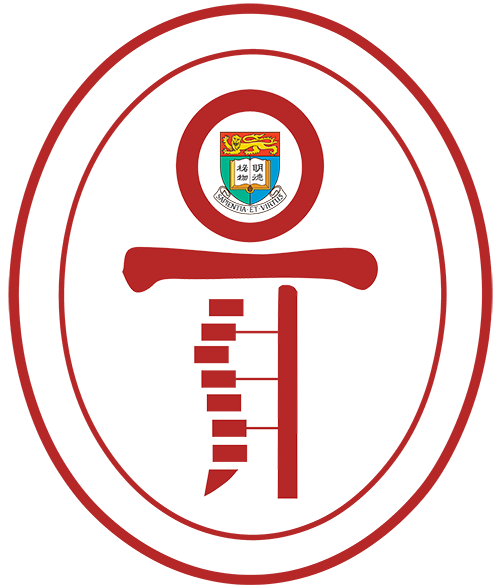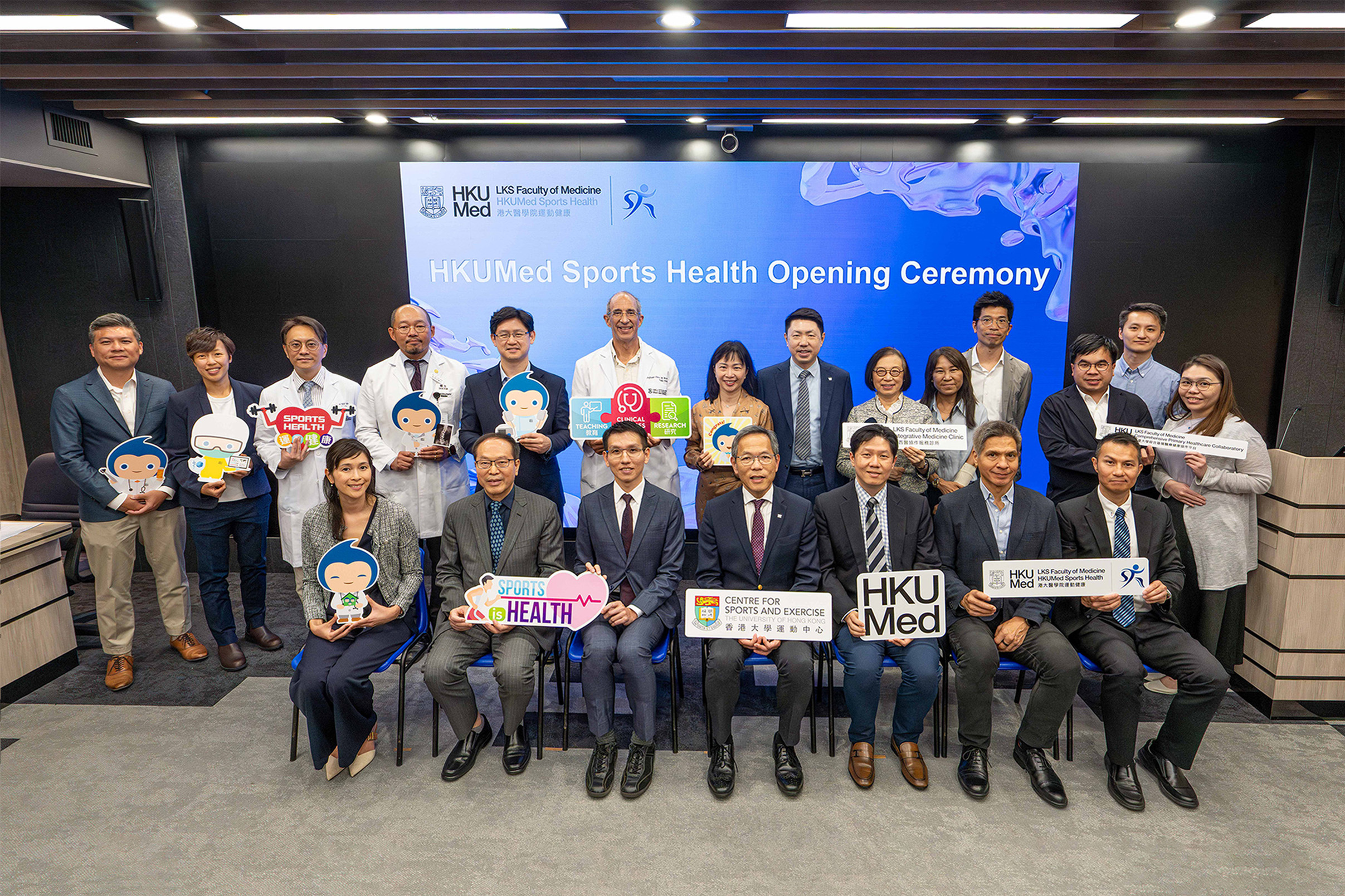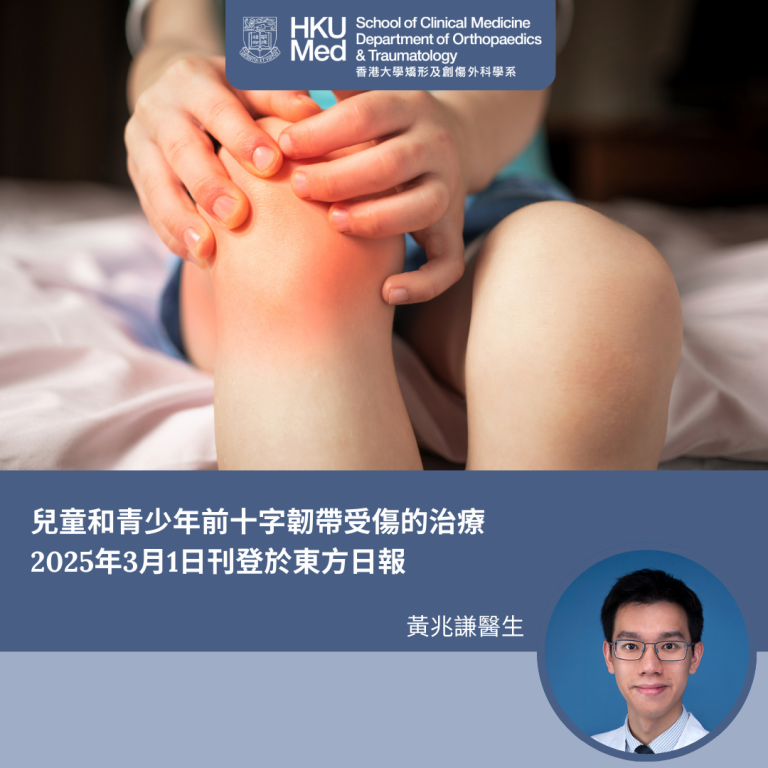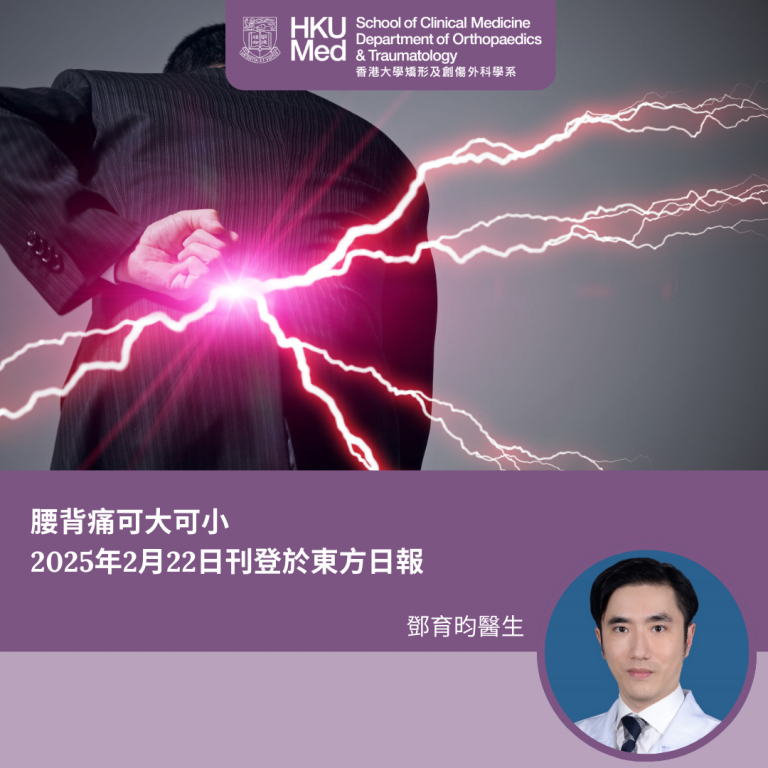HKUMed clinical study validates immediate brace weaning and elimination of six-month protection period allowing scoliosis teens to resume normal life 港大醫學院臨床證實可免六個月矯形保險期 即時停戴脊柱支架助青少年患者重投正常生活

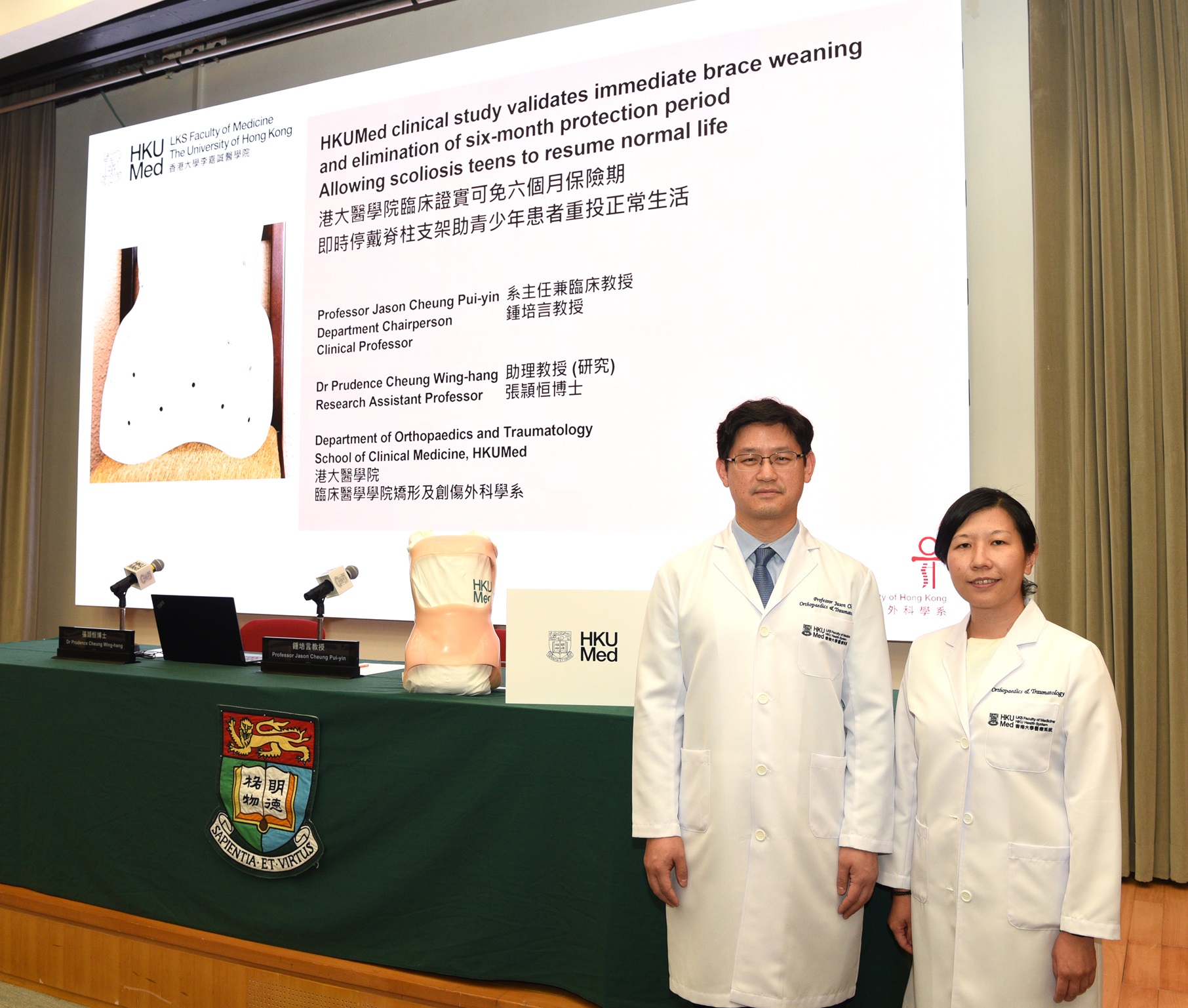
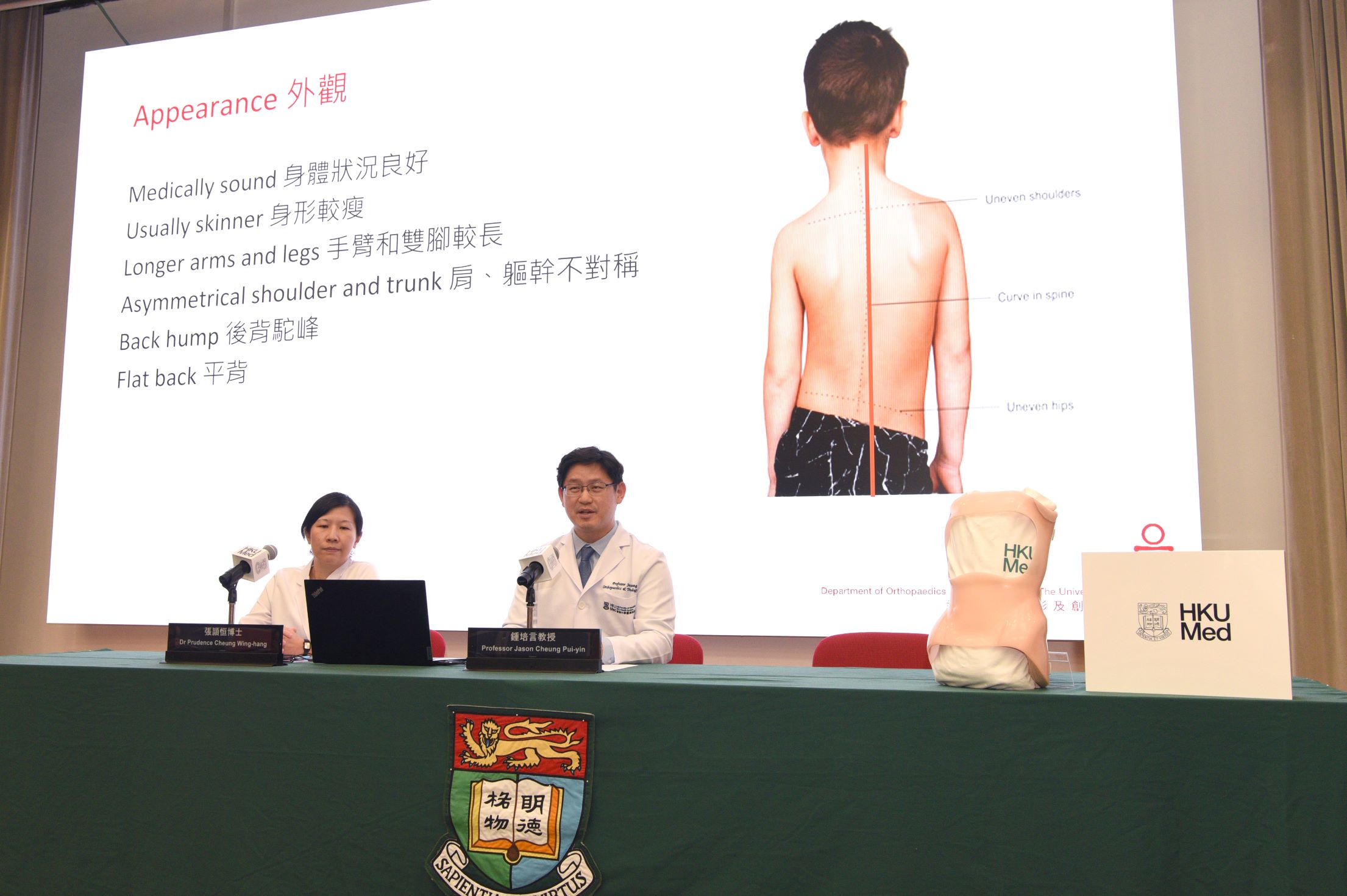
02 October 2024
A research team from the Department of Orthopaedics and Traumatology, School of Clinical Medicine,
LKS Faculty of Medicine at the University of Hong Kong (HKUMed), has conducted the largest
clinical trial on brace weaning to date. The study revealed that immediate brace removal is the
preferred strategy for patients with adolescent idiopathic scoliosis (AIS) once their skeletal
development is mature, providing effective evidence to cancel the current standard protection
period. The team discovered that gradual weaning, with night-time brace wear for an additional six
months, offers no advantages in maintaining spinal curvature or enhancing the patients’
health-related quality of life (HRQoL). This pivotal finding could reshape treatment protocols for
AIS, prioritising patient well-being over the uncertain benefits of prolonged brace use. The
findings of the clinical trial were published in the journal JAMA Pediatrics.
Background
Idiopathic scoliosis is a lateral spinal curvature,
whose cause is unknown, affecting 3–4% of adolescents in Hong Kong. It is more common in females
(8:2 ratio). According to the standard criteria from the Scoliosis Research Society, bracing is
recommended for skeletally immature patients with spinal curves between 25 and 40 degrees,
particularly for girls who are pre-menarche or within one year of menarche onset and have not
received prior treatment.
The aim of bracing is to prevent worsening curvature
during rapid growth phases, especially during puberty, to avoid the need for surgery. Orthopaedic
specialists prescribe braces that are custom-made for optimal comfort. Currently, there is a lack
of evidence and consensus regarding the brace-weaning protocol for AIS. Many clinicians recommend
gradual weaning to prevent curve deterioration after removal, which can lead to prolonged brace
wearing and negatively affect spinal stiffness and HRQoL.
Research method and findings
From 2017 to 2020, the research team recruited 369 patients with AIS who had undergone
underarm brace treatment and reached skeletal maturity at the Duchess of Kent Children’s Hospital.
A randomised controlled trial was conducted over the following two years, from 2020 to 2022, along
with follow-up studies. According to the pre-set randomisation sequence, 193 patients were
allocated to the immediate brace-removal group, and 176 patients followed a gradual weaning
protocol, which entailed an additional six months of night-time wear before complete cessation.
The
research team investigated changes in major curve size and truncal balance of the patients through
routine spine radiographs and patient questionnaires at follow-up intervals of 6, 12 and 24
months. They also assessed HRQoL using refined Scoliosis Research Society 22-item (SRS-22r) and
EuroQol five-dimension questionnaires. The findings indicated minimal differences of changes
between the two groups, with a mean difference of less than one degree for the major curve and 1.5
degrees for minor curve in terms of curve size, truncal balance and HRQoL.
Further
analysis revealed that skeletal maturity and major curve Cobb angle at the time of weaning were
the key factors influencing curve progression two years after brace treatment, and the weaning
protocols showed no correlation with curve deterioration after brace treatment. The team also
compared the changes in truncal balance between the two groups, which revealed that both immediate
and gradual weaning effectively maintained comparable truncal balance. Key parameters assessed
included truncal shift, listing, shoulder height, thoracic kyphosis and lumbar lordosis. These are
the crucial indicators of how well the patients balance their torso with the presence of the
spinal curve.
Importantly for patient care, the research team also found that the
patients’ HRQoL was similar for both weaning protocols. Conventionally, gradual weaning is
considered a better way to help alleviate muscle discomfort that can arise from sudden strain when
transitioning away from the brace, as immediate weaning is believed to lead to more back pain.
However, both weaning protocols demonstrated comparable HRQoL outcomes, including overall quality
of life and specific aspects, like pain. The SRS-22r pain domain scores showed no significant
differences between the two groups at any follow-up time-point, and the EQ-5D scores further
confirmed that overall quality of life was similar for both weaning strategies.
Significance of the study
There is a lack of evidence and consensus regarding brace-weaning protocols for AIS
worldwide, often leading clinicians to prescribe gradual weaning even when patients have reached
skeletal maturity. This prolonged bracing can lead to muscle weakness, spinal stiffness and
continuous discomfort associated with brace wear.
‘This largest randomised
controlled trial on AIS brace weaning across the globe provides compelling evidence that gradual
weaning is not superior to immediate weaning, as was commonly believed. Appropriate cases should
now be considered for immediate weaning, which allows patients to return to higher levels of
physical activity and exercise earlier. The approach will help avoid the overuse of brace
treatment and facilitate a quicker return to normal life, helping them regain their confidence,’
said Professor Jason Cheung Pui-yin, Chairperson and Clinical Professor in the Department of
Orthopaedics and Traumatology, School of Clinical Medicine, HKUMed.
This clinical
trial provides high-quality evidence that could significantly impact clinical practice in the
future. ‘We deeply appreciate the commitment of the research team, as well as the efforts and
contributions of all participating patients and their families,’ commented Dr Prudence Cheung
Wing-hang, Research Assistant Professor in the same department. ‘HRQoL is a crucial aspect that
our spine surgeons consider, in addition to the scoliotic curves presented by patients. Through
the use of specific questionnaires and expertise analyses, we elicit patients’ HRQoL and enable
our clinicians to effectively gauge their overall well-being during and after treatment.’
About the research team
The research was led by Professor
Jason Cheung Pui-yin, Chairperson and Clinical Professor; and Dr Prudence Cheung Wing-hang,
Research Assistant Professor; both from the Department of Orthopaedics and Traumatology, School of
Clinical Medicine, HKUMed.
Acknowledgements
This research was
supported by the Hong Kong Government’s Health and Medical Research Fund
Related media interviews
Toronto Chinese Newspaper – Ming Pao Daily
Vancouver Chinese Newspaper – Ming Pao Daily
Find out more about scoliosis: https://scoliosis.hku.hk/en/
More on:
https://www.med.hku.hk/en/news/press/20241002-ot_ais_bracewean
港大醫學院臨床證實可免六個月矯形保險期 即時停戴脊柱支架助青少年患者重投正常生活
2024年10月02日
香港大學李嘉誠醫學院(港大醫學院)臨床醫學學院矯形及創傷外科學系的科研團隊進行了最大的隨機對照試驗,研究脊柱矯形支架的使用效益。研究顯示,對於青少年原發性脊柱側彎(AIS)患者,一旦其骨骼於矯形後發展成熟,應考慮立即停戴矯正器(下稱「支架」),取消現行普遍的保險期。研究指出,逐步停戴支架的治療方案,需要患者於晚間佩戴支架多六個月,但這對維持脊柱彎曲度和改善健康相關生活質素方面,並沒有顯著的效果。這一關鍵發現可能改變未來AIS的治療方案,將優先考慮患者的身心健康,而不會因沒有科研實證的好處而延長佩戴支架的時間。有關臨床實驗的結果已於《JAMA Pediatrics》期刊發表。
背景
AIS是一種成因不明的脊柱畸形疾病,影響本港3至4%青少年,在女性中較為普遍,男女患病比例為2:8。根據脊柱側彎研究學會的標準,支架適用於骨骼發展尚未成熟、脊柱彎曲度為25至40度的患者,尤其是初次月經前或開始後一年內的女性患者,且在之前未曾接受任何治療。
佩戴支架的主要目的是防止患者在青春期時脊柱側彎的情況惡化,需要進行手術。骨科專科醫生會指導患者開始支架治療,度身訂製以確保舒適。目前對於AIS支架停戴方案仍缺乏充分證據和共識,導致許多醫生傾向採取逐步停戴支架的方式,以避免脊柱側彎在停戴支架後惡化,但這可能導致延長佩戴時間,或引起脊柱僵硬,並影響患者的健康相關生活質素。
研究方法及結果
研究團隊於2017至2020年期間,在大口環根德公爵夫人兒童醫院招募了共369名曾接受腋下支架矯形治療並達到骨骼成熟的AIS患者,在2020至2022年間進行對照試驗,並進行後續研究。根據隨機順序,193名患者被分配到即時停戴支架組別,176名患者則採用逐步停戴支架治療,即額外在晚間佩戴支架六個月。
研究團隊通過常規的脊柱X光檢查和問卷調查,評估患者在停戴支架後六個月、12個月和24個月的主要側彎度和軀幹平衡的變化,同時使用脊柱側彎研究學會SRS-22r 病人問卷和歐洲五維健康量表(EuroQol
5-dimension,簡稱EQ-5D)問卷評估健康相關生活質素。結果顯示,兩組之間無顯著差異,即患者的側彎度變化(主要側彎度的平均差異在一度內,次要側彎度則為1.5度內)、軀幹平衡和健康相關生活質素量方面差異極微。
研究團隊進行深入分析後發現,骨骼成熟程度和停戴支架時的主要脊柱側彎角,是影響支架治療後兩年內脊柱彎曲度的關鍵因素,而採用何種佩戴支架方案與脊柱側彎惡化無關。研究團隊還比較了兩組患者的軀幹平衡變化,結果顯示無論是即時停戴還是逐步停戴,兩組患者在維持軀幹平衡的表現相近,主要評估指標包括軀幹偏移、傾斜、肩膀高度、胸椎後凸和腰椎前凸,這些都是脊柱專科醫生在評估患者如何平衡脊柱側彎時的重要參數。
對於患者的生活質量和護理而言,研究還發現兩種支架佩戴方案,患者健康相關生活質素無明顯差異。傳統上,一般認為逐步停戴支架能減緩支架突然移除後的肌肉不適,而即時停戴則可能會加劇背痛。然而,研究顯示兩種治療方式在健康相關生活質素上表現相若,包括整體生活質素和具體指標如痛楚程度。在SRS-22r問卷中,兩種方式在痛楚方面所有隨訪時間點的得分均沒有顯著差異;而EQ-5D問卷的得分亦顯示兩組的整體生活質素非常接近。
研究意義
由於醫學界對AIS支架停戴方案仍未有證據和共識,醫生多傾向採取逐步停戴支架方案,即使患者的骨骼已發展成熟。然而,長時間佩戴支架可能為患者帶來肌肉無力、脊柱僵硬等持續不適。
港大醫學院臨床醫學學院矯形及創傷外科學系系主任兼臨床教授鍾培言教授表示:「這項全球最大規模的 AIS 支架停戴隨機對照試驗提供有力的臨床證據,證明逐步停戴支架並不比即時停戴更有效。因此,合適的患者應採取即時停戴支架方案,免進行六個月保險期,避免支架佩戴時間過長,這將有助盡早恢復難度高的活動和運動,讓患者盡快回復正常生活,重拾自信。」
這項臨床試驗為相關醫學提供了重要的證據支持,對未來臨床實踐影響深遠。同一學系的助理教授(研究)張頴恒博士補充:「我們非常感謝研究團隊的努力,以及所有參與試驗的患者及其家人的參與和支持。我們和脊柱外科醫生不僅關注患者的脊柱側彎情況,對患者的生活質素同樣重視。透過特定的問卷和專業分析,我們得以更深入了解患者的健康相關生活質素,有效協助醫生評估患者在治療過程期間和治療後的整體身心狀況。」
關於研究團隊
此項研究由港大醫學院臨床醫學學院矯形及創傷外科學系系主任兼臨床教授鍾培言教授和助理教授(研究)張頴恒博士領導。
鳴謝
本研究獲得香港政府醫務衞生局的醫療衞生研究基金資助。
相關媒體報道
Toronto Chinese Newspaper – Ming Pao Daily
Vancouver Chinese Newspaper – Ming Pao Daily
更多脊柱側彎資訊: https://scoliosis.hku.hk
更多內容
https://www.med.hku.hk/zh-hk/news/press/20241002-ot_ais_bracewean

